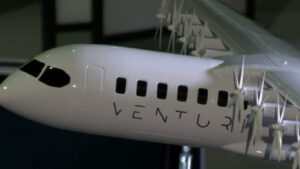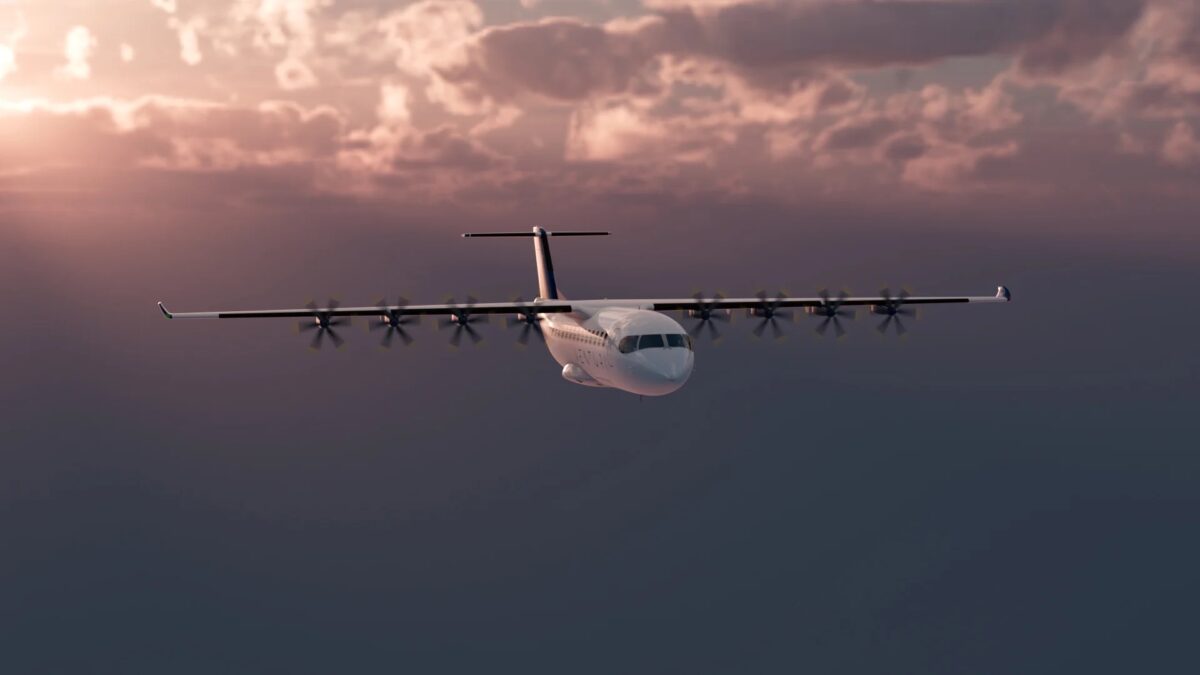With several entrepreneurial endeavors already behind him, Jan-Willem has been working on sustainable solutions for years now, yet it is perhaps the latest venture, co-founded with fellow entrepreneur and former aviation engineer Joost Dieben, that is set to make some real big impact. Together, they co-founded Venturi Aviation – with the ambitious goal to create the first electric commuter plane.
And to avoid keeping their audience in the dark for too long, earlier this month they announced their plans and the concept of their first aircraft: Echelon 01. Last Thursday, they finally unveiled their all-electric, 44-passenger aircraft.

An electric commuter aircraft – now more tangible than ever
The reveal of the Echelon One concept was a moment Jan-Willem, Joost and industry stakeholders had been looking forward to for some time. While small electric aircraft have been in development over the past years, none of them were actual passenger planes. The move of Venturi is a step forward not only in helping decarbonize aviation but also in setting a new technological standard in the industry.
Surely, this is not an overnight project, so Venturi aims to complete its first aircraft by 2029. “Our aircraft will drive the 100% sustainable transformation of today’s regional air travel industry. In its wake, Echelon 01 will also significantly reduce flight operating cost, maintenance cost and noise pollution,” Jan-Willem says.
As Jan Willem grew up in an entrepreneurial family – his father founded his own company aimed at commercializing and integrating e-mobility solutions, it was only a matter of time for Jan-Willem and his co-fonder to embrace sustainability and create something of his own.
After graduating from the TU Eindhoven in Industrial Design (BSc) and Innovation Management (MSc), he founded ViriCiti – a company that developed a monitoring system for fully electric buses. It became a European leader in its market and was eventually acquired by American electric vehicle infrastructure company ChargePoint.
Alongside this first venture, he founded a second one, too. Maxem, initially a SaaS energy management system, later made a pivot to a hardware and cloud solutions company that enables customers to install e-mobility and sustainable energy at scale. It was around that time that Joost joined the team and the two got to planning even bigger and better things.
“I felt like with Maxem I also had only limited success and I wanted to have more impact. And what makes more impact than creating an electric aircraft,” Jan-Willem says. With Joost’s background in aviation engineering, it didn’t take long for them to lay the foundation of Venturi Aviation.
Embarking on a long and capital-intensive journey
Designing and developing a new type of aircraft, especially based on some of the latest technology out there, is inspiring but it cannot possibly come without its fair share of challenges.
“With Venturi, our initial plan was to create a commuter plane that could transport 50 people and have a range of 1,000km,” Jan-Willem says. “That was the estimate we made in August 2020.” Yet, because they are in the early stages of a long-term project, the two co-founders knew they needed to make very accurate estimates.
Batteries are heavy, but the aircraft needs to be light. We soon realized that the range of 1000km was impossible to make even with the technology of the near future, so we started to cut it down.
In the midst of this, Jan-Willem and Joost got in touch with Dutch Airliners and the input they gathered set them on the path they are now. With the expectation being that the number of people travelling by air will grow in the future, airliners main requirement for such a future aircraft was to hold the highest possible number of passengers.
“A shorter flight range was not a concern for them,” Jan-Willem says, “as the batteries for a frequently operating electric aircraft would need to be replaced every 1.5-2 years, and the technology will be gradually improving in the meantime. The range will come.”
At the moment, the Echelon 01 is being designed to transport 44 people at a distance of up to 550km.
Running such a long-term business sure requires a strong vision. For the team, this translates to: Electrifying aviation and decreasing the industry’s burden on the environment.
Of course, “it also requires planning, patience, cash and a great team,” as Jan-Willem puts it. It is a capital-intensive endeavor, and it also needs the right people backing it. “Our main challenge is getting people to believe this is possible.”
To date, Jan-Willem and Joost have put a lot of their own finances to get the project going and they were later joined by several angel investors. At the start of 2022, they aim to close an investment round of 3.75 million euros that will allow them to move on to the next stage of the development: conceptual design. With that, they will also look to expand – and possibly double – their team.
Delivering an electric aircraft is hard, but we are driven by the goal that we will make a polluting industry so much better.




